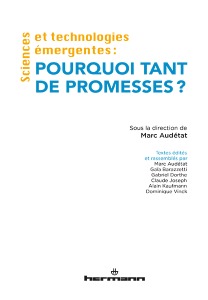This is my third article about the book Sciences et technologies émergentes, pourquoi tant de promesses? After the general considerations on the system of promises, the book presents contributions describing specific areas:
I.3: nanotechnologies
II.1: semiconductors through Moore’s Law
II.2: big ata
II.3: digital Humanities
III.1: neurosciences and psychiatry
III.2: The Human Brain Project (HBP)
III.3: personalized medicine
III.4: biodiversity and nanomedicine
IV.1: assisted reproduction
IV.2: regenerative medicine
Each chapter is interesting for the curious reader as it shows the dynamics between promises and expectations of stakeholders (researchers, politicy makers, general public). The chapter about the HBP is particularly interesting in the description of the disconnection between content and form. “How was it possible that the HBP “won the competition” despite the lack of evidence to establish pragmatically the scientific relevance and the legitimacy of its ambitious organizational goals? We develop the hypothesis that this deficit, criticized afterwards, was both hidden and compensated by the production of promises shaped to anticipate and / or respond effectively to the political, economic, social and health-realted stakes on the agenda of the “challenges to come”. [Page 166] The credibility of the HBP sealed by this decision has been built […] following an adaptation process and reciprocal validations in the double register of the politicization of science and the scientification of politics. In other words, we show that one of the important conditions of this credibility was the successful co-production of a strategic congruence between [scientific] promises and the agenda of policy issues. [Page 171] The connection between knowledge of the brain and forms of social life took place mainly in the domain of discourse. […] In this contrasting situation, discursive inflation around the brain and neuroscience seems to be the consequence of a lack of evidence, as if it had overcome, positively or negatively, the differences between the present and the future, the proven and the possible, the absence and the desire. This regular feature of big science projects has resulted in the development and implementation of a prophetic rhetoric that seeks to anticipate the possibility of a better future by borrowing to the notions of hope and promise.” [Page 176-77]
I come back to a quote from chapter 3 that is essential to me as a conclusion to this new post: The real progress of techno-science will less come from their ability to keep promises than from their ability to do without them, to inherit critically from the era of great technological promise. This is not to break an idol, but to learn how to inherit. [Page 111]

